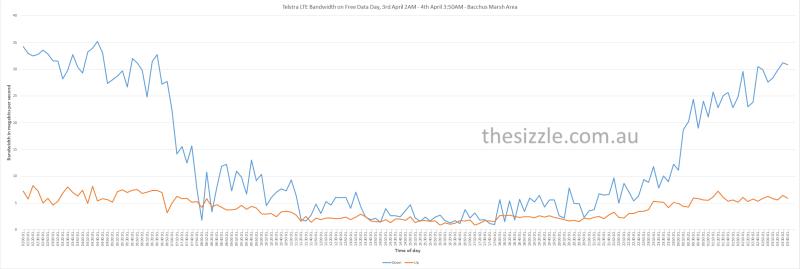
Telstra turned off the data billing system on Sunday, as compo for a national network outage a few weeks ago. This is the second time Telstra's had this freelech day for its customers and I had a hunch people would be better prepared to take full advantage of Telstra's “generosity”.
I was up late on Saturday night and decided to try and log the quality of Telstra LTE in Bacchus Marsh (where I live) and see how hard people hit the free data, even though Bacchus Marsh is covered in NBN and the people living here really don't need free mobile data as every home here can get 100mbit fibre with no data caps, if you're that keen for fast Internet.
It's a rather crude test, just a Raspberry Pi running speedtest-cli every 10 minutes (which itself adds to the congestion), but it's better than nothing. The device I used to get on to the LTE network is a Huawei 5372T, which has a Category 4 LTE modem inside, capable of 150/50 speeds. Bit old now, but it's the fastest device I had on hand besides my iPhone and I didn't want my iPhone tied up all day just doing speed test.

This test isn't supposed to find out the fastest Telstra speed possible – my modem was located in a shit spot, didn't have a full signal, is in a regional town and wasn't using the latest modem. It was more to see if there's any trends, than to find the right conditions for max download speed or the best latency.
Of course, this is just a small sample of a single tower (likely to be Site ID 50537, but could be 300276, I dunno for sure), so might not reflect your experiences with the Telstra LTE network on that day. For all I know, it could have held up pretty well in the inner city/CBD areas.
Anyway, here's the latency chart (click/tap to see it big). You can see that pings were fine until around 8AM and they never really recovered until about 11:30PM.

Bandwidth is similar story. Speeds really shit the bed around 8AM too and didn't recover until around midnight, when people stopped leeching. However the free data continued for me at least, until 4AM – I was using a pre-paid SIM with no credit on it, so when the free data ran out at 4AM, the tests stopped working.

So what do these charts mean? What can we gather from this? I don't have a “normal” day to compre against, so I can't say “well bandwidth was down 20% and latency down 40%”, but it's pretty clear that the Telstra network was performing well below averge.
8AM-Midnight averages
Latency – 910ms
Download – 5.30mbit/s
Upload 2.62mbit/s
2AM-8AM & Midnight-4AM averages
Latency – 90ms
Download – 30mbit/s
Upload 4mbit/s
Entire free data period averages
Latency – 602ms
Download – 13.47mbit/s
Upload 3.93mbit/s
The time of day when people are awake and expect decent Telstra connectivity saw 910ms latency! 910ms! That's worse than the dial-up days. I understand if bandwidth is constrained, but providing such shit latency makes even the most basic of tasks like web browsing, a slow mess. It's ironic that Telstra was offering free data as an apology for their network crapping out, an event which in turn, caused the network to crap out. There won't be any sort of compensation for an entire day of rubbish latency and low bandwidth.
I'm pretty Teltra did this face-saving measure instead of simply giving all its customers a day or half day of network access fees back (i.e: you pay $100/m? Here's a $3.29 credit for the day of disruption, $1.65 for half a day) because a day of free data costs Telstra way less than refunding it's ~10m customers half a day of a mobile plan. They're happy to sacrifice a day of network quality so they don't have to sacrifice a few bucks. Plus imagine if all you received as compensation for that half-day outage was like 66c (I pay $40/m – which is $1.32/day, only 66c), they'd cop more of a backlash over that (“fucken Telstra only gave me 66c!”) than over a Sunday where the network was slow, but still worked. Smart.
